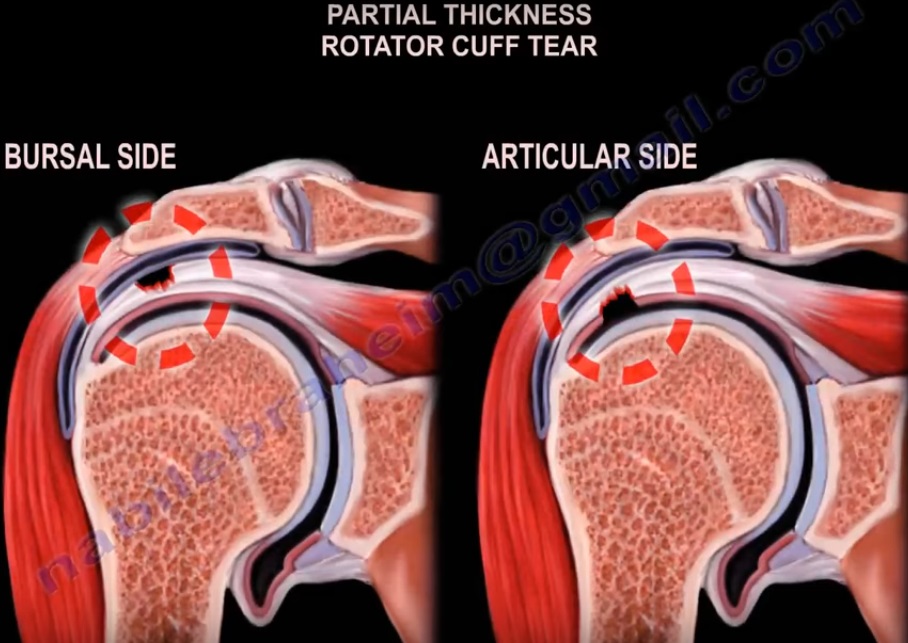Courtesy: Prof Nabil Ebraheim, University of Toledo, Ohio, USA
SHOULDER PAIN
- Common causes of shoulder pain includes impingement.50% of all patients who go to the doctor for shoulder pain will have an impingement syndrome.
- With rotator cuff tendonitis, raising the arm is painful.
SHOULDER BURSITIS
(SUBACROMIAL BURSITIS)
- Elevation of the arm causes squeezing of the bursa located above the supraspinatus tendon and below the acromion.
- Bursitis is a frequent cause of shoulder pain and usually occurs in conjuction with an impingement syndrome.
- Irritation of this bursa will often cause pain due to overuse.
o Tears of the rotator cuff is a common cause of pain associated with the shoulder.
o Most tears occur in the supraspinatus tendon and the tear can be either partial or complete, with complete tears of the tendon usually requiring surgery.
o With tears of the rotator cuff, the patient is unable to raise the arm.
o The active range of motion of the shoulder will be lost but the passive range of motion will be intact.
o The patient also will complain of night pain.
Night pain could mean that conservative treatment will not work and that the patient will need surgery!
o MRI is very helpful in patients with a rotator cuff tear.
Not only can it evaluate the integrity of the tendons but it can also evaluate atrophy of the muscles.
o The problem with the MRI of the shoulder and rotator cuff tears is that there is high percentage of false positive result.
o In asymptomatic patients that are 60 years old or older, you find that 55% of asymptomatic patients will have rotator cuff tears.
The MRI will show a lot of tears that are asymptomatic and the percentage of these tears increases with age.
o Biceps tendonitis is a condition that affects the area where the biceps muscle meets the front of the shoulder.
Tendonitis of the biceps usually develops as a result of rotator cuff tendonitis.
o The labrum is a cuff of tissue surrounding the rim of the glenoid which helps to keep the head of the humerus in place within the shoulder joint.
o Tears of the glenoid labrum is often associated with significant shoulder pathology.
Two of the most common labral injuries are:
1.SLAP
2.BANKART
o SLAP tear is different from a Bankart lesion.
The SLAP tear is not common and it is difficult to diagnose.
o SLAP tear occurs at the point where the tendon of the biceps muscle inserts on the labrum.
- The pain associated with a SLAP tear is deep within the shoulder or in the back of the shoulder.
- The patient complains of catching, popping, or clicking sensation.
- Pain when throwing a ball and pain with overhead activities.
- The O’brien’s test is the most commonly used test for the diagnosis of a SLAP tear.
- MRI arthrogram is usually helpful.
o Bankart lesion occurs as a result of dislocation of the shoulder that ultimately tears the labrum.
o The anterior labral tear can occur in ANTERIOR dislocation of the shoulder.
o The posterior labral tear can occur in POSTERIOR dislocation.
o The AC joint is located at the top of the shoulder where the acromion of the scapula and the clavicle join together.
The AC joint can be affected by inflammation, by arthritis, by osteolysis or injury.
o Osteolysis of the distal end of the clavicle can be seen, especially in weight lifters.
o Another common cause of shoulder pain is arthritis of the shoulder.
The patient will have global pain with decreased painful range of motion that is restricted.
X-ray will show the arthritis.
TREATMENT OF SHOULDER PAIN
- The treatment of shoulder pain depends entirely on the cause of the problem.
- Shoulder pain can be caused by a variety of problems and the treatment always depends on the exact diagnosis of the problem which may need not only clinical exam but studies such as x-rays and MRI.
- We may also need to differentiate shoulder pain that is caused by a shoulder problem from a referred shoulder pain that is caused by a cervical spine problem.

Leave a Reply